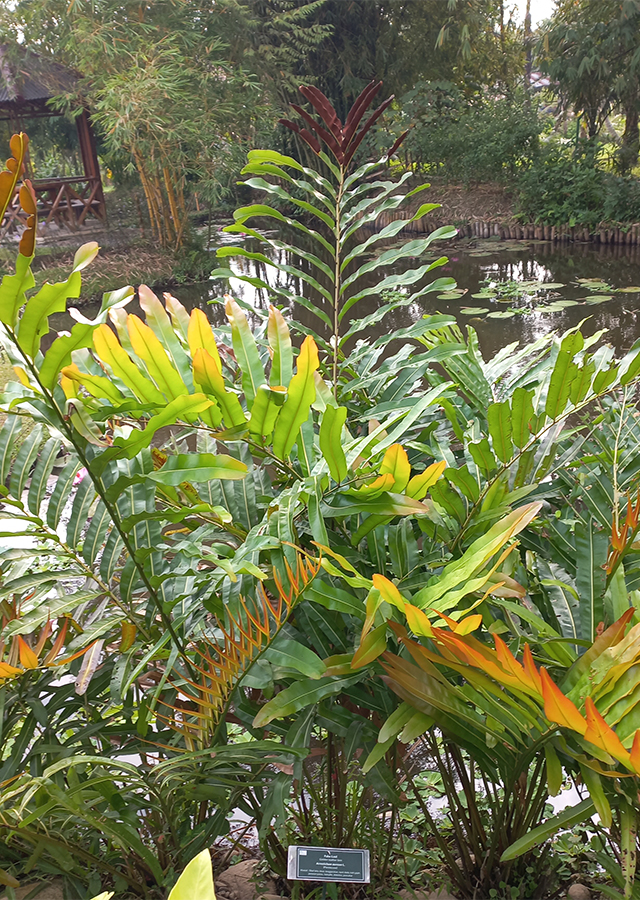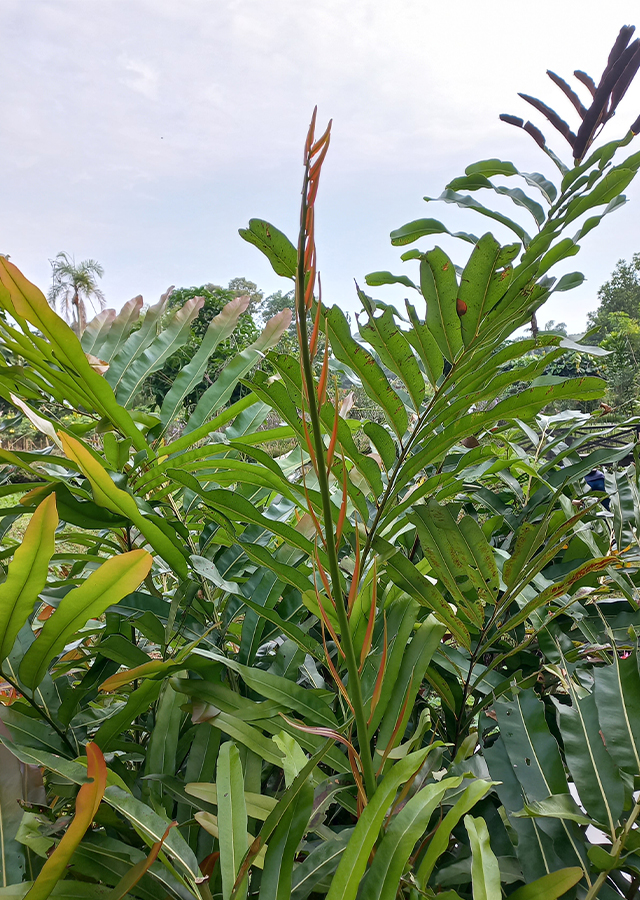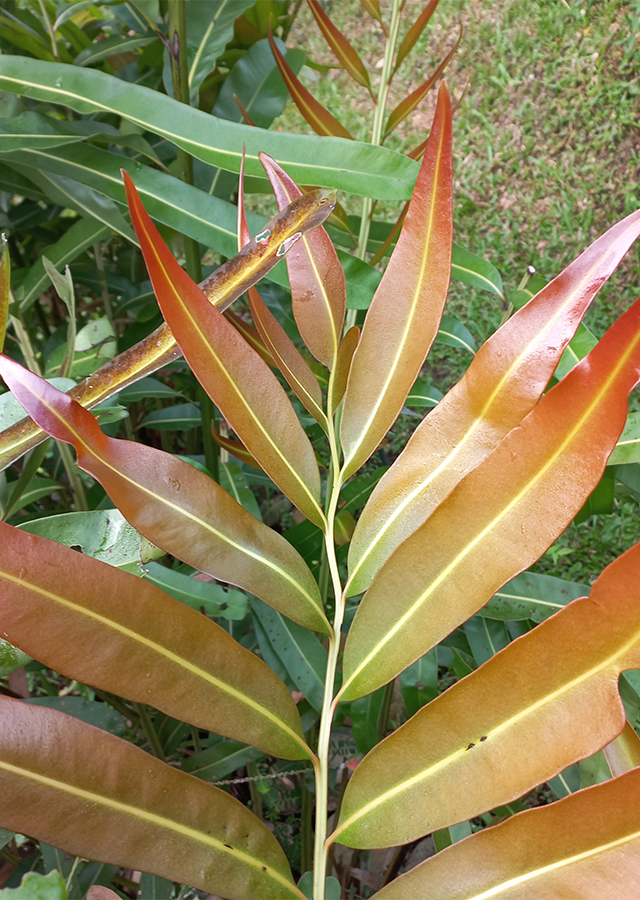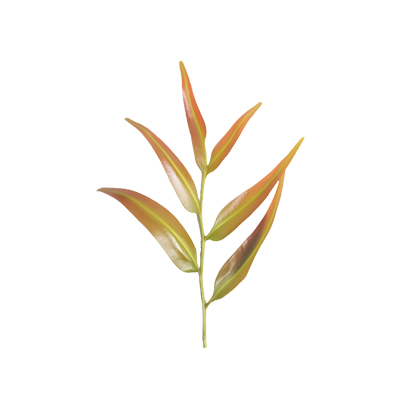Golden Leather Fern
Acrostichum aureum L.
Pteridaceae
Location in our garden
Orchard



Synonym
Asplenium arifolium Burm.f.
Polystichum dissimulans Maxon
Acrostichum crassifolium Wall.
Habitus
Fern. Golden leather fern is a mangrove fern, growing up to 3 m tall, and thrives well under full sun
Part Used
Leaves
Roots
The Whole Plant
Rhizome
Growing Requirements
Full Sunshine
Need Shade
Habitat
Aquatic
Forest
Coastal
Overview
Acrostichum aureum spread in the tropics and subtropics. It is a pioneer species of mangrove sites growing rapidly and colonizing in disturbed habitats especially in the wetland areas. Plants of this species are useful in the mangrove restoration. The plant is sometimes harvested from the wild for local use as a food and material for thaching. An ornamental plant, it can be grown in gardens. In Malaysia, Indonesia (Kalimantan, North Sulawesi, Kangean), and the Philippines, the young shoots can be consumed as vegetables, but this plant contains thiaminase, an enzyme that robs the body of B-complex vitamins, so consuming it cooked first will remove the thiamine. Apart from being used as traditional medicine, vegetables, and ornamental plants, Vietnamese and Pacific people have used hard, dry, parchment-like leaves that are sewn together and then used as roofing material (as a substitute for straw).
Vernacular Names
Coarse swamp fern, Mangrove fern, Swamp fern (English), Jin jue, Lu jue (Chinese), Minni (India), Paku tiai, Kalakeok, Kerakas, Wihakas (Indonesia), Alligator rush, Crab thatch, Golden fern, Gold fern (Jamaica), Piai raya, Paku bulu emas, Paku laut, Larat, Peye, Piai, Piai lasa, Umbi piai, Pebisi (Malaysia), Karen koku (Sri Lanka), Ráng, Ráng Äại(Vietnamase).
Agroecology
A plant of the humid lowland tropics and subtropics. Very cold sensitive, it is intolerant of frost. Requires a permanently moist position and a position with bright, filtered light. Plants can succeed in saline or non-saline conditions. Young plants can tolerate a change between the two conditions but older plants become accustomed to either saline or non-saline and are unlikely to survive a change.
Morphology
- Stems - fibrous rhizomes (underground, horizontal stems) have a scaly surface.
- Leaves - dark green, erect fronds are composed of 24 - 30 pinnae (leaflet-like structure) in alternate arrangement (1 - 4 m long, 0.12 - 0.5 m wide). The petiole of the frond (known as the stipe) is usually about 1 m long. The 5 - 8 pairs of pinnae near the tip are fertile with their underside covered in reddish brown sporangia (except the midrib), while the remaining pinnae are infertile. The pinnae are oblong with a blunt tip (8 - 50 cm long, 1 - 7 cm wide) and bright red when immature. The pinnae which bear the sporangia are restricted to the upper parts of a frond at varying proportions. The sporangia and the sterile hairs (paraphyses) among them will cover the whole lower surface of the pinnae, giving it a dark brown appearance. Its spores are dispersed by wind.
- Flowers - non-flowering plant.
Cultivation
Naturally propagated by spores. Vegetative propagation can be made possible by division of clumps and rhizome cuttings.
Chemical Constituents
Beta-sitosterol, alkaloids, flavonoids, phenolics, catechins, saponins, tannins, reducing sugars, glycosides, gums, terpenoids, triterpenoids, steroids, five phytosterols (stigmasterol, y-sitosterol, campesterol, cycloartanol, and 24-methylene cycloartanol). Two new sesquiterpenes, (2R,3S)-sulfated pterosin C (1) and (2S,3S)-sulfated pterosin C (2), along with two known derivatives ((2S,3S)-pterosin C and (2R)-pterosin P).
Traditional Medicinal Uses
Used for healing of stubborn ulcers, wounds, boils, as antidote for snake bites, styptic and anthelmintic, and as an astringent in hemorrhage, syphilitic ulcers, as emollient, for sore throat, chest pains and elephantiasis, for constipation and as purgative, as febrifuge, used for cloudy urination in women, treating pharyngitis, chest pains, and diabetes.
Part Used
Reference Sources
- Useful Tropical Plants Database. 2021. Acrostichum aureum. https://tropical.theferns.info/viewtropical.php?id=Acrostichum+aureum 22-11-2021.
- Stuartxchange. 2019. Lagolo. http://www.stuartxchange.org/Lagolo. 22-11-2021.
- Flora Fauna Web. 2021. Acrostichum aureum L.. https://www.nparks.gov.sg/florafaunaweb/flora/1/5/1535. 22-11-2021.
- PROSEA. 2016. Acrostichum aureum (PROSEA). https://uses.plantnet-project.org/en/Acrostichum_aureum_(PROSEA). 2-10-2021.



